Birds of a Feather Flock Together: The Social Side of School Reform
Dr. Michelle Penn • Cahn Fellow 2022
Who were your friends in school? How did they influence who you are today? Oftentimes in education reform, educational leaders think about having more money, school and class size, better curriculum, professional development for both teachers and school leaders, better parental involvement, and of course more testing for data analysis and progress monitoring so they can transform their schools. If those components alone could turnaround a school, then low performing schools would not exist. For instance, educational funding has dramatically increased (especially in New York and even adjusted for inflation), yet low performing schools continue to be a major issue. When relationships are considered in education reform beyond teacher to student and parent to teacher, then we can begin to see that the missing ingredient in school reform is often one that is the most influential component of the social capital of students, which are their peers and the influence they have on each other and their academic behaviors that can lead to long term economic mobility. After all, your social network determines your net worth.
The purpose of this mixed-methods study was to examine the impact of the socioeconomic integration of students coming from families of various economic status on student outcomes. Eight high schools of varying academic performance and economic status participated in this socioeconomic integration study. Each school sent 25-30 students to a site for shared instruction and other experiences for half of a school day of career and college connected learning. This study only focuses on one of the target schools in need of improvement, serving a high concentration of students in poverty.
This study found that the integration of the high and low performing and socioeconomic status schools resulted in a positive change in student achievement at the target school, including the graduation rate improving from 53% to 95% over time. Recommendations from this study include system leaders ensuring enrollment procedures create school communities that are socioeconomically and academically diverse to develop the social capital of all students to lead to better student outcomes and ultimately economic mobility. School leaders serving underperforming schools with high concentrations of students coming from impoverished backgrounds take the initiative to partner with school leaders serving the complete opposite communities to offer shared college and career connected instruction and experiences to support the integration of students of various backgrounds towards improved academic achievement and economic mobility.

